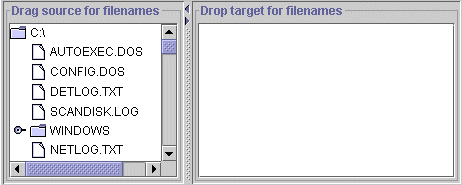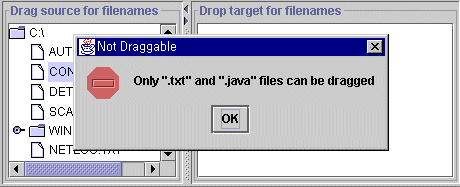1900 Drag & Drop의 구현
스윙에서의 Drag & Drop 을 구현해 보자. 과정이 꽤 복잡하고 기능상에 약간의 제약은 있으나 한번 구현해 볼 만한 예제라고 생각을 한다. 소스코드는 자바소프트에서 발췌했음을 알아두길 바란다. 중간중간에 풍선도움말을 두겠으니 단풍잎에 마우스를 갖다대면 도움말이 뜨니 참고하길 바란다.
 Drag & Drop step Drag & Drop step |
Drag & Drop 을 구현하는 것은 비교적 쉽다. 그렇지만 가장 난해한 것은 모든 과정에 대해서 이해하는 것이다. 다음의 순서를 먼저 익혀두길 바란다. [ DnD Source Download]
1. Drag source 에 대한 참조를 가진다. - DragSource.getDefaultSource() 나 new DragSource() 를 통해서.
2. Drag gesture recognizer 를 생성한다. - DragSource.createDafaultGestureRecognizer()
3. Drop target 를 생성한다. - 하나의 컴포넌트와 Drop target listener 를 명세한다.
4. Transferable 로 옮겨질 수 있는 데이타를 wrap 한다.
5. Drag 를 초기화한다. - DragSource.startDrag()
6. DropTargetLisenter, DragSource 인터페이스를 구현함으로써 Drop 를 핸들링한다.
Drag & Drop (이하 D&D) 는 하나의 datasource 와 여러개의 droptarget 에 - 흔히 콤포넌트와 연관되어져 있다 - 와 연관되어 이뤄진다. 다음에 나열된 클래스와 인터페이스는 D&D 에서 사용되는 것을 정리한 것이다. 대부분의 것들은 java.awt.dnd 패키지에 있고, 오직 하나 Transferable 은 java.awt.datatransfer 패키지에 있다.
DragGestureRecognizer : 컴포넌트에서 drag 를 수행할려고 할때 이벤트를 발사한다.
DragSource : Drag 와 DragGestureRecognizer 를 초기화한다.
DropTarget : 연관된 컴포넌트 상에서 Drop 이 일어난다.
Transferable ; D&D 를 통해서 전송되어지는 데이타를 위한 Wrapper 이다.
DragGestureListener : DragGestureRecognizer 에 의해 통보를 받고 drag 를 초기화한다.
DragSourceListener : DragSource 이벤트에 반응한다.
DropTargetListener : Drop 포함한 target 이벤트를 핸들링한다.
D&D 는 하나의 기미(Gesture) 즉, 마우스를 내려서 드래깅을 시도할때 초기화된다. 그러면 DragGestureRecognizer 는 이런 기미를 포착하고 이벤트를 발생하는 것이다.
DragSource 는 startDrag() 메소드로 초기화작업을 수행하고, createDragGestureRecognizer() 나 createDafaultDragGestureRecognizer() 를 이용하여 DragGestureRecognizer 를 생성하게 되는 것이다.
DropTarget 은 하나의 컴포넌트와 Listener 객체와 연관되어 있어서 drop target event 가 발생할때 listener 객체가 통보를 받게 된다.
DragGestureListener 는 recognizer 에 의해 drag gesture 를 통보받는데 전형적인 반응예는 DragSource.startDrag() 메소들르 호출하게 되었을 경우이다.
DragSourceListener 는 drag 가 초기화된 후 dragsource 에서 일어나게 된다.
다소 나열적인 설명이었지만 어느 정도 감을 잡기 위해서 중복 설명했다. D&D 하는 과정과 메소드호출, 클래스와 인터페이스의 API 를 꼼꼼하게 살펴보면 이해할 수 있으리라 생각한다. 가장 기본적인 D&D 를 하기 위해서는 반드시 DragSource, DropTarget, DragGestureRecognizer, Transferable 이 반드시 생성이 되어야 하고, Listener 가 구현되어야 한다는 것을 명심하길 바란다. 그러나 실제 구현은 몇가지 객체를 생성하고 데이타를 Wrapping 하고 핸들링하는 것을 빼면 나머지 동작은 프로그래머 재량에 상관없이 자체적으로 구현이 된다. |
 Adding D&D to Swing Component Adding D&D to Swing Component |
여기서도 두가지 방법이 있을 수가 있는데 한가지 방법으로는 Swing Component 를 상속해 객체를 만들어 그것을 DragSource, DropTarget 으로 만들어 사용하는 방법과 제 3의 콤포넌트를 생성해 두가지를 수행하는 방법이 있다.
첫번째 방법으로 수행을 하면 반드시 객체만이 D&D 특성을 가질수가 있고, 표준 Component 는 그런 특성을 공유할 수 없음을 명심하길 바란다. 가령 JList 를 상속한 ListDragSource 객체를 만들어서 D&D 를 추가해 사용한다면 ListDragSource 만이 그런 동작을 할 수 있다는 것을 의미한다.
아래에 있는 그림은 이 프로그램을 실행시켰을때 볼 수 있는 화면이다. 왼쪽은 DragSource 로 JTree 를 이용해 구현했고, 오른쪽은 DropTarget 은 JTextPane 을 이용해 구현했음을 보길 바란다. 이것은 .txt 와 .java 로만 한정되어 있기 때문에 다른 확장자를 가진 파일을 D&D 했을 경우에는 에러창을 발견하게 될 것이다. 그리고 .txt 와 .java 파일은 그 내용을 JTextPane 에서 볼 수 있을 것이다.
오른쪽의 파일을 D&D 수행할 수가 있다
확장자가 .txt 와 .java 가 아닐 경우에 볼 수 있는 경고창이다.
위의 프로그램은 얼마든지 응용해서 확장할 수 있다고 생각한다. 다른 파일도 볼 수 있게끔 할 수 있고, image 도 가능하리라 생각한다.
다음 장에서는 소스코드 분석에 들어가도록 하겠다. 먼저 해당 API 를 꼼꼼히 살펴본 다음에 코드분석에 임하길 바란다. |
 Source Analysis Source Analysis |
Test.java 소스이다. main() 와 기본 인터페이스가 설정돼 있다. 아래의 코드를 살펴보면 알겠지만
Test 생성자는 drop target 을 생성해낸다.
즉 TextPane 을 drop target component 로 생성하는 것이다.
실제 drop 이 일어났을때 Test.drop() 메소드가 호출이 된다. drop 과 연관된 transferable 은
String 으로써 데이타를 제공해주며 drop 을 받아들인 후에 readFile() 메소드가 호출이 돼
file 의 내용을 TextPane 으로 로딩을 하게 된다.
Drop 이 완료된 후 e.dropComplete(true) 가 호출이 돼 실제 drop 이 완료되게 된다. import javax.swing.*;
import javax.swing.event.*;
import javax.swing.text.*;
import java.awt.*;
import java.awt.event.*;
import java.awt.datatransfer.*;
import java.awt.dnd.*;
import java.io.*;
public class Test extends JFrame implements DropTargetListener {
private JTextPane textPane = new JTextPane();
public Test() {
super("Drag and Drop With Swing");
new DropTarget(textPane,DnDConstants.ACTION_COPY_OR_MOVE,this);
JSplitPane splitPane =
new JSplitPane(JSplitPane.HORIZONTAL_SPLIT,createTreePanel(),createTextPanel());
splitPane.setDividerLocation(250);
splitPane.setOneTouchExpandable(true);
getContentPane().add(splitPane, BorderLayout.CENTER);
}
public static void main(String args[]) {
Test test = new Test();
test.setBounds(300,300,850,350);
test.setVisible(true);
test.setDefaultCloseOperation(WindowConstants.DISPOSE_ON_CLOSE);
test.addWindowListener(new WindowAdapter() {
public void windowClosed(WindowEvent e) {
System.exit(0);
}
});
}
private JPanel createTreePanel() {
JPanel treePanel = new JPanel();
DragTree tree = new DragTree();
treePanel.setLayout(new BorderLayout());
treePanel.add(new JScrollPane(tree), BorderLayout.CENTER);
treePanel.setBorder(BorderFactory.createTitledBorder(
"Drag source for filenames"));
return treePanel;
}
private JPanel createTextPanel() {
JPanel textPanel = new JPanel();
textPanel.setLayout(new BorderLayout());
textPanel.add(new JScrollPane(textPane),BorderLayout.CENTER);
textPanel.setMinimumSize(new Dimension(375,0));
textPanel.setBorder(BorderFactory.createTitledBorder(
"Drop target for filenames"));
return textPanel;
}
private void readFile(final String filename) {
EditorKit kit = textPane.getEditorKit();
Document document = textPane.getDocument();
try {
document.remove(0,document.getLength());
kit.read(new FileReader(filename), document, 0);
}
catch(Exception ex) {
ex.printStackTrace();
}
}
public void drop(DropTargetDropEvent e) {
try {
DataFlavor stringFlavor = DataFlavor.stringFlavor;
Transferable tr = e.getTransferable();
 | public class DataFlavor extends Object implements Externalizable, Cloneable
이 클래스는 D&D 수행할 때 클립보드에 들어가는 데이타의 형태를 제공해주는 클래스이다.
여기서 사용된 StringFlavor 는 java Unicode String class 을 나타낸다.
MimeType = "application/x-java-serialized-object" 을 나타내게 된다.
|
if(e.isDataFlavorSupported(stringFlavor)) {
String filename = (String)tr.getTransferData(stringFlavor);
e.acceptDrop(DnDConstants.ACTION_COPY_OR_MOVE);
// 인자로 넘어온 액션으로 drop 을 받아들인다.
readFile(filename);
textPane.setCaretPosition(0);
// Text 의 첫줄이 TextPane 의 첫줄에 오게끔 설정한다.
e.dropComplete(true);
}
else {
e.rejectDrop();
// Drop 을 거절한다.
}
}
catch(IOException ioe) {
ioe.printStackTrace();
}
catch(UnsupportedFlavorException ufe) {
ufe.printStackTrace();
}
}
// DropTargetListener 메소드를 구현한 부분이다.
public void dragEnter(DropTargetDragEvent e) { }
public void dragExit(DropTargetEvent e) { }
public void dragOver(DropTargetDragEvent e) { }
public void dropActionChanged(DropTargetDragEvent e) { }
}
|
< 출처 : http://www.javastudy.co.kr/docs/b612/swing/draganddrop.html >

